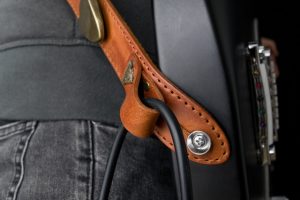A Buyer’s Guide from the UK’s Best Guitar Strap Brand.
Things to Consider when Buying a Guitar Strap
So, you need a guitar strap? You’ve saved up your pocket money and want something that will do the job and last a long time too. It may seem like a daunting process with so much choice out there, and you may be asking yourself (or Google) what the best guitar strap brand is or perhaps looking for the most comfortable guitar strap. Obviously, our answers to those questions may be a little biased so we’ll try and stick to some general pointers on how to work out what exactly it is you need to look out for in a guitar strap (besides holding up your guitar). The four main things to consider are measurements, purpose, comfort, and durability.

Measuring
The first thing you need to know is what size strap you’ll need. Now, we’ve often found that length isn’t listed by many guitar strap brands online or in a shop but we fail to see why – it’s not like one size fits all. If you already have a strap that you use, then it’s pretty easy to find your desired length. Set the strap to the length you wear it and measure from the middle of the buttonhole at one end to the middle of the buttonhole at the other. However, if you don’t currently have a strap, then you need to consider two things to find your most comfortable guitar strap: your height and size, as well as where you like your guitar to sit when you play. Depending on personal preference, all guitarists wear their instruments at different positions to play their best.
Guitar strap brands vary, but using the sizes of one of our single-buckled straps as an example, someone who is 5’10” and average build, who plays their guitar across their stomach, would be best suited to a medium (49”) strap, that measurement being directly in the middle of the 6-inch adjustments we have on all our straps of this type. However, a taller person, or someone of the same height but significantly bigger boned would be better with a larger size than that. If you prefer to play the guitar higher up so you can almost rest your chin on it, you’d want a smaller size. If you play with the guitar down by your knees or just love the duck walk, then go for a large.
If you want to be more precise, you can hold the guitar in your desired position and use a tape measure to measure from one button, across your shoulder, down to the other button (this will probably require assistance). As for width, the wider your strap is, the more it will distribute the weight of the guitar across your shoulder so heavy guitars might call for wider straps. Having said that, we’ve worked with some big blokes with big basses in the past that have specifically requested the thinnest strap we do… so there’s still an element of personal preference here.
And don’t forget to check the size of the strap buttons on your guitar! Most will be the standard 8mm, but some are 6mm, strap-locks suit 10mm holes, and others have different sized buttons at the front and rear of the guitar. Measuring this will mean you can get a strap with the perfect buttonhole size to avoid any embarrassing (and expensive) accidents. Be aware though that most of the off-the-peg straps you’ll encounter will just have the 8mm buttonhole.
Purpose
Are you buying a strap for one particular instrument, or one that needs to be used on multiple guitars and worn in different positions? Do you need something to be kind to a shoulder that is sore from the many hours dedicated to making great music? Do you need something to house your electronics such as a transmitter and cables? The most comfortable guitar straps will have padding or a shoulder pad to reduce the chance of injury, and the best guitar strap brands will have a response for each of the above questions, such as offering cable tidies or a transmitter pouch. Knowing your needs is an essential step in choosing the perfect strap to enhance your performance.
Comfort
No matter what your reason is for buying a guitar strap, comfort should always be high on your list of criteria. The more comfortable your strap is, the easier you will find it to play, as your muscles will be relaxed, and everything will flow a little easier.
But comfort isn’t just about the softness of the material; the width and length of a strap can also determine the most comfortable guitar strap for you. You need a strap that holds the guitar in the best position for you and fits the shape of your shoulder properly. Do you struggle with shoulder problems, or find straps dig into your shoulder a bit too severely? If so, consider a wider strap, a good-sized shoulder pad or one with some built-in padding.

Durability
There is very little point buying a strap that isn’t going to last, that’s why we think full-grain leather is the perfect material to use. It is unmatched in durability and longevity, and if looked after properly, can be with you for life. That durability needs to be functional too, not just something that’s going to retain its look. The best guitar strap brands won’t simply disintegrate with use, especially around the buttonholes, where the material has already been cut open to accommodate the buttons. It is in this area that many low-quality straps will split, perhaps to the point of threatening to drop your baby mid-gig…

Style
Ok, this last one is a bonus. But you want to look good, so think about whether you want your strap to blend in with your outfit or stand out from it, match your guitar or contrast it. A drab strip of canvas won’t do any of that, and we won’t even discuss it in regard to style. Thankfully, all Heistercamp’s straps tick this box, so as long as you choose us, you only have to worry about the other four things.
Ultimately, there is no set template for buying a guitar strap, every guitarist is unique, and a good strap will reflect that. Choosing a high-quality, durable material (like leather) is always a winner. Measure the strap to the height of your guitar at your preferred playing position, and the buttonholes too. Get something that is comfortable enough to wear over long sets without a break, and consider any other criteria you may have based on your reason for buying a strap; for example, a persistent injury or use with multiple instruments. Even with the best guitar strap brands, style really is secondary to the other factors, and if you find a strap that has style in addition to those factors, then you’ve really lucked out. Oh, look at that, you’re already on the Heistercamp website. Fancy that…